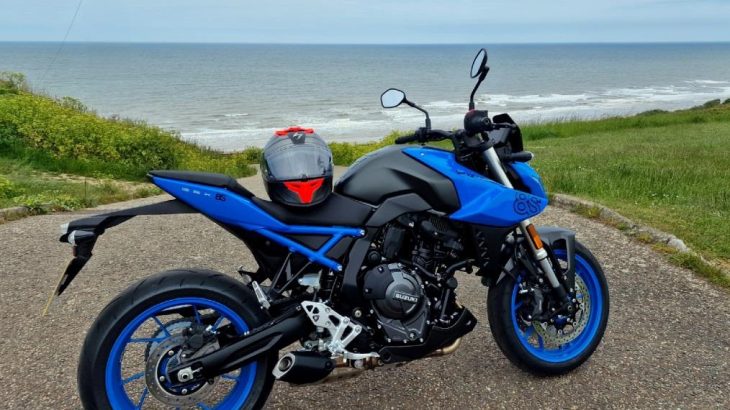Recently I found myself in the market for replacement steed and my category of choice was a new middleweight street bike. After months of research and looking at various models I settled on the new Honda CB750 Hornet. I’d had a test ride and absolutely loved it. Anyway, I visited my local dealer (C J Ball in Norwich, Norfolk) to let them know what spec I wanted and to place the order. Now, I’d seen snippets of information here and there about a new Suzuki that was coming out but to be honest I hadn’t really given it much thought.
Curiosity Got the Better of Me
C J Ball are a dual franchise dealer, Honda and Suzuki, and while I was there, I spotted the new Suzuki GSX 8S over on the Suzuki forecourt. Intrigued I wandered across to have a look, more out of curiosity than anything else. To cut a long story short, I test rode the Suzuki back-to-back with the new Honda Hornet and went for the new Suzuki instead. I have to say that both bikes are fantastic and if you’re in the market for this size of bike then they’re both well worth a look. I opted for the Suzuki GSX 8S because it suited my style of riding more.

A New Dawn for Suzuki
The GSX 8S (I’ll refer to it as just the 8S from now) is a brand-new model from Suzuki. There is no carryover or revamped parts from older models. As far as I’m aware, it’s the first true all-new, big bike platform from the firm since the SV650 in 1999. The 8S is a 776cc Parallel Twin producing 82 bhp @ 8500rpm and 78Nm of Torque @ 6800rpm. The engine also uses a 270° firing pattern that mimics V-twin delivery and with a twin balancer shaft layout.
The engine is as smooth as silk with zero vibration. The amount of sheer grunt available is remarkable. For example, it’ll pull in 6th gear from as little as 2000rpm with next to no hesitation or fuss. The engine does seem to run out of steam slightly as it nears the red line but knocking it up a gear sees you’re rewarded with another surge of acceleration from that torquey motor.

Impressive new engine
A Diet Needed?
In terms of dimensions, the 8S is on the heavier side compared its rivals, its 202kg. That makes it 12kg heavier than Honda’s Hornet, 18kg more than Yamaha’s MT-07 and the about the same as KTM’s 790 Duke. It’s 2kg heavier than an SV650. It’s also a comparatively big bike, it’s the same overall length as a GSX-S1000 and has a 5mm longer wheelbase. But don’t let that fool you into thinking the 8S is heavy or hard to manage.
Flicking the 8S around on a combination of tight hairpins and long, open bends at a decent pace, the Suzuki is the perfect balance of size, weight and stability. It steers and tracks a line with reliable, predictable precision. I have found the bike so very easy to handle and not at all intimidating. It’s an easy bike to ride slowly, ideal for weaving around slow moving and stationary traffic around town.

A149 Roadside Ormesby St. Michael
The 8S comes with a 5-inch TFT display which is very clear and easy to read. It’s unaffected by bright sunlight and also self-dims automatically when it needs to: Like riding at night or if you suddenly find yourself riding through a dark wooded area. Unfortunately, there is no Bluetooth connectivity available here which is not an issue for me but may disappoint some.

Textbook: Crisp, clear and concise
Spoilt for Choice
Like a lot of modern-day bikes, the 8S comes with ABS, traction control and rider modes. The traction control has four settings including off. Additionally the rider modes (called SDMS – Suzuki Drive Mode Selector) has three settings. ‘A’ mode is the equivalent of sport mode, with the most aggressive response setting. ‘B’ mode is your everyday standard mode and ‘C’ mode is for wet/slippy conditions. A useful feature is that the traction control and rider modes can all be adjusted very easily while you’re riding. No need to stop or fiddle with complicated menus.
All of the usual stuff is also featured on the display: gear indicator, speed (mph or kmh), rev counter, two trip computers (which calculate MPG’s), clock, engine temp, fuel gauge. The TFT also lets you know which traction control and rider mode you’re currently in. Headlights and brake lights are all LED while the indicators remain old school bulbs. LED indicators are available as on option but it would have been nice for these to be standard, in my opinion.
Slick shifter
An up/down quickshifter is also standard equipment. This can be switched off in the settings on the TFT display if you prefer. I found the quickshifter to be excellent when you’re picking up the pace. Both upshifts and down are seamless and precise. My only criticism is that at very slow speed I have found it to be a tad clunky. However, when you’re in town and creeping past slow-moving traffic, then feathering the clutch for better bike control is more important than faster gear changes via the quickshifter. I’m just in the habit now of using the clutch normally around town and then enjoying the quickshifter when the pace starts to pick up when you leave the urban jungle.
Comfortable & Economical
The riding position is spread out and generously spaced. Its seat is wide, supportive and made from the right density of foam. There’s plenty of leg room, and the bars are the right angle and distance from the rider’s body to make an aggressive, but not aggravating, stance. Front suspension is non-adjustable upside-down forks and the rear shock is a mono with seven pre load settings. Even though the suspension set up is fairly basic the ride is good and is reassuringly firm. This works for me as I’m more of a fan of a firmer ride rather than something with a softer setup that feels like it’s bouncing along giving that unsure feel when cornering.
Regarding economy, in the two weeks of ownership the trip computer is telling me that I’ve averaged 61.5 mpg. However, seeing as I’m still running the engine in so have been taking it relatively easy, I expect this will drop a bit when I can give it some more beans. Tank size is 14 litres (just over 3 gallons) so is par for the course for this category of bike. I would’ve liked a slightly bigger tank but there you go.
Added Bling
At the moment there’s not a huge selection of accessories available as it’s a new model. I have fitted the front visor screen, which does help to deflect the buffeting that you get from a naked upright bike. A single seat cowl has been added: I don’t require a pillion seat. Finally I’ve also installed an under cowl, which is like a mini belly pan. Other mods that I’m looking at are a tail tidy. I’m not a huge fan of that rear fender and maybe an after-market exhaust system.


Speaking of the exhaust, the one on the 8S is so very quiet. When you are riding at low speed around town you can hardly hear it. However, when you hit the open road and open the throttle, you get a satisfying deep-down roar from that 270-degree firing pattern. It’s quite a short stubby exhaust with most of it hidden out of sight beneath the bike. I’m pretty sure that Akrapovic, Scorpion etc. will soon be releasing their exhausts to fit the 8S. So people can choose whether to keep things quite or if they want to be heard from a mile away.
Well Put Together
Fit and finish is excellent and the build quality appears to be top notch. For instance, using aluminium for the swing arm rather than steel. It’s the finishing touches that make all the difference: The bike doesn’t feel as if it’s lacking anything or cut price in any area. The painted subframe, bolt-specs, the colour scheme and general finish in the cockpit, the clocks, it all adds up to make the 8S a more pleasant place to spend your riding time.
Time Will Tell
Reliability is still an unknown quantity being a brand-new engine and all. However given the engine is not in a high-revving, high-stress state of tune, I’m pretty confident that it’ll soon prove itself.
Suzuki faces some tough competition in this sector of the market and time will tell if they’ve got themselves a winner, or not.
Words and Pictures: David Chan 05/06/2023

